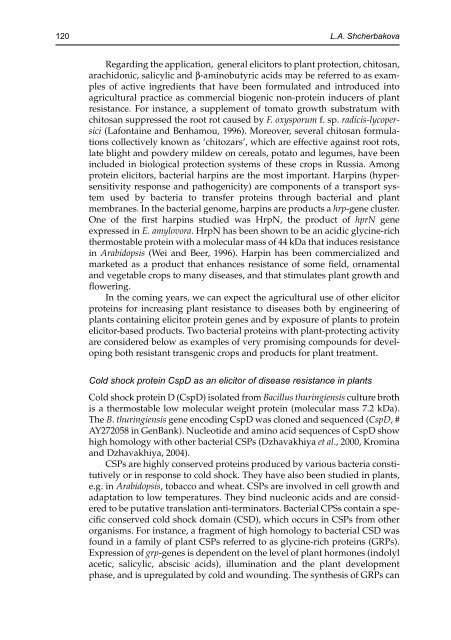natural-products-in-plant-pest-management
natural-products-in-plant-pest-management
natural-products-in-plant-pest-management
Create successful ePaper yourself
Turn your PDF publications into a flip-book with our unique Google optimized e-Paper software.
120 L.A. ShcherbakovaRegard<strong>in</strong>g the application, general elicitors to <strong>plant</strong> protection, chitosan,arachidonic, salicylic and β-am<strong>in</strong>obutyric acids may be referred to as examplesof active <strong>in</strong>gredients that have been formulated and <strong>in</strong>troduced <strong>in</strong>toagricultural practice as commercial biogenic non-prote<strong>in</strong> <strong>in</strong>ducers of <strong>plant</strong>resistance. For <strong>in</strong>stance, a supplement of tomato growth substratum withchitosan suppressed the root rot caused by F. oxysporum f. sp. radicis-lycopersici(Lafonta<strong>in</strong>e and Benhamou, 1996). Moreover, several chitosan formulationscollectively known as ‘chitozars’, which are effective aga<strong>in</strong>st root rots,late blight and powdery mildew on cereals, potato and legumes, have been<strong>in</strong>cluded <strong>in</strong> biological protection systems of these crops <strong>in</strong> Russia. Amongprote<strong>in</strong> elicitors, bacterial harp<strong>in</strong>s are the most important. Harp<strong>in</strong>s (hypersensitivityresponse and pathogenicity) are components of a transport systemused by bacteria to transfer prote<strong>in</strong>s through bacterial and <strong>plant</strong>membranes. In the bacterial genome, harp<strong>in</strong>s are <strong>products</strong> a hrp-gene cluster.One of the first harp<strong>in</strong>s studied was HrpN, the product of hprN geneexpressed <strong>in</strong> E. amylovora. HrpN has been shown to be an acidic glyc<strong>in</strong>e-richthermostable prote<strong>in</strong> with a molecular mass of 44 kDa that <strong>in</strong>duces resistance<strong>in</strong> Arabidopsis (Wei and Beer, 1996). Harp<strong>in</strong> has been commercialized andmarketed as a product that enhances resistance of some field, ornamentaland vegetable crops to many diseases, and that stimulates <strong>plant</strong> growth andflower<strong>in</strong>g.In the com<strong>in</strong>g years, we can expect the agricultural use of other elicitorprote<strong>in</strong>s for <strong>in</strong>creas<strong>in</strong>g <strong>plant</strong> resistance to diseases both by eng<strong>in</strong>eer<strong>in</strong>g of<strong>plant</strong>s conta<strong>in</strong><strong>in</strong>g elicitor prote<strong>in</strong> genes and by exposure of <strong>plant</strong>s to prote<strong>in</strong>elicitor-based <strong>products</strong>. Two bacterial prote<strong>in</strong>s with <strong>plant</strong>-protect<strong>in</strong>g activityare considered below as examples of very promis<strong>in</strong>g compounds for develop<strong>in</strong>gboth resistant transgenic crops and <strong>products</strong> for <strong>plant</strong> treatment.Cold shock prote<strong>in</strong> CspD as an elicitor of disease resistance <strong>in</strong> <strong>plant</strong>sCold shock prote<strong>in</strong> D (CspD) isolated from Bacillus thur<strong>in</strong>giensis culture brothis a thermostable low molecular weight prote<strong>in</strong> (molecular mass 7.2 kDa).The B. thur<strong>in</strong>giensis gene encod<strong>in</strong>g CspD was cloned and sequenced (CspD, #AY272058 <strong>in</strong> GenBank). Nucleotide and am<strong>in</strong>o acid sequences of CspD showhigh homology with other bacterial CSPs (Dzhavakhiya et al., 2000, Krom<strong>in</strong>aand Dzhavakhiya, 2004).CSPs are highly conserved prote<strong>in</strong>s produced by various bacteria constitutivelyor <strong>in</strong> response to cold shock. They have also been studied <strong>in</strong> <strong>plant</strong>s,e.g. <strong>in</strong> Arabidopsis, tobacco and wheat. CSPs are <strong>in</strong>volved <strong>in</strong> cell growth andadaptation to low temperatures. They b<strong>in</strong>d nucleonic acids and are consideredto be putative translation anti-term<strong>in</strong>ators. Bacterial CPSs conta<strong>in</strong> a specificconserved cold shock doma<strong>in</strong> (CSD), which occurs <strong>in</strong> CSPs from otherorganisms. For <strong>in</strong>stance, a fragment of high homology to bacterial CSD wasfound <strong>in</strong> a family of <strong>plant</strong> CSPs referred to as glyc<strong>in</strong>e-rich prote<strong>in</strong>s (GRPs).Expression of grp-genes is dependent on the level of <strong>plant</strong> hormones (<strong>in</strong>dolylacetic, salicylic, abscisic acids), illum<strong>in</strong>ation and the <strong>plant</strong> developmentphase, and is upregulated by cold and wound<strong>in</strong>g. The synthesis of GRPs can


